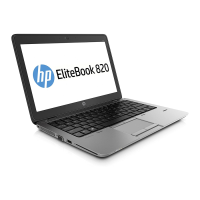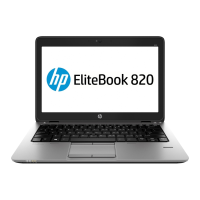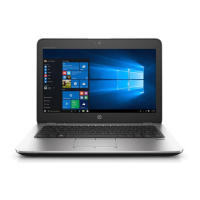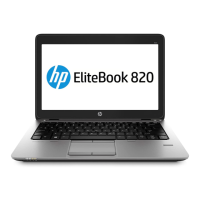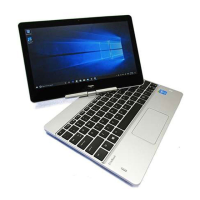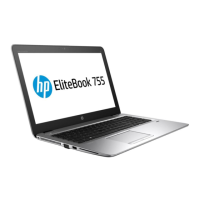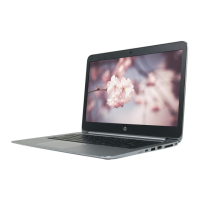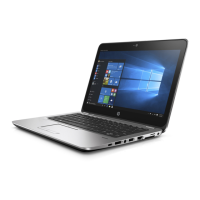Do you have a question about the HP EliteBook 820 G3 and is the answer not in the manual?
Details on the Intel Core processors and Skylake Premium chipset used in the notebook.
Information on the different panel types, resolution, and brightness levels available.
Details on memory module slots, RAM support, and available hard drive and SSD configurations.
Specifications for audio capabilities, webcam, WLAN, and WWAN wireless modules.
Identification and function of various ports like USB, DisplayPort, RJ-45, and audio jacks.
Description of keyboard features, touchpad functionality, and pointing stick.
List of preinstalled, restore, and web-only supported operating systems.
Identifies ports and connectors on the right side of the laptop.
Identifies ports and features on the left side of the laptop.
Identifies components on the laptop display, including cameras and microphones.
Identifies components on the top surface, including the touchpad and pointing stick.
Explains the function of indicator lights and keyboard control buttons.
Identifies components on the bottom and front of the laptop.
Explains where to find serial number, product number, and warranty period.
Lists major computer components with their spare part numbers.
Details the parts that make up the display assembly.
Lists the spare parts included in the plastics kit.
Lists the spare parts included in the cable kit.
Lists available hard drive and solid-state drive options with spare part numbers.
Lists various other spare parts such as AC adapters and power cords.
Lists the necessary tools for performing disassembly and assembly procedures.
Provides important considerations for handling components during disassembly and assembly.
Covers guidelines for handling cables, connectors, and drives to prevent damage.
Explains precautions to prevent electrostatic discharge (ESD) damage to components.
Provides guidelines for setting up a safe workstation and using grounding equipment.
Step-by-step instructions for removing and replacing the bottom cover.
Instructions for safely removing and installing the computer battery.
Procedure for removing and replacing the computer's hard drive.
Instructions for removing and installing a Solid-State Drive (SSD).
Procedure for removing and installing memory modules.
Instructions for removing and replacing the WLAN/Bluetooth combo card.
Procedure for removing and replacing the WWAN module.
Step-by-step instructions for removing and replacing the keyboard.
Procedure for removing and replacing the system board.
Instructions for removing and replacing the Real Time Clock battery.
Procedure for removing and replacing the heat sink and fan assembly.
Instructions for removing and replacing the fingerprint reader assembly.
Procedure for removing and replacing the touchpad button board.
Instructions for removing and replacing the NFC module.
Procedure for removing and replacing the smart card reader board.
Instructions for removing and replacing the speaker assembly.
Procedure for removing and replacing the display assembly.
Instructions for removing and replacing the top cover.
Overview of Computer Setup, including starting and navigating.
Procedure for returning BIOS settings to their factory default values.
Instructions for determining BIOS version and downloading updates.
Changing boot order via F9 prompt and modifying TPM settings.
Information on HP Sure Start technology for BIOS protection and recovery.
Overview of Computer Setup, including starting and navigating.
Procedure for returning BIOS settings to their factory default values.
Instructions for determining BIOS version and downloading updates.
Changing boot order via F9 prompt and modifying TPM settings.
Information on HP Sure Start technology for BIOS protection and recovery.
Overview of Computer Setup, including starting and navigating.
Procedure for returning BIOS settings to their factory default values.
Instructions for determining BIOS version and downloading updates.
Changing boot order via F9 prompt and modifying TPM settings.
Information on HP Sure Start technology for BIOS protection and recovery.
Procedure for initiating hardware diagnostic tests using UEFI.
Instructions for downloading HP PC Hardware Diagnostics (UEFI) to a USB device.
Information on creating recovery media and system backups.
Steps for creating HP Recovery media for system recovery.
Utilizing Windows tools for system restore points and personal information backups.
Covers HP Recovery Manager, recovery partition, and media usage.
Procedures for changing boot order and removing the HP Recovery partition.
Steps for backing up personal files and system information.
Tools and methods for performing system recovery and fixing issues.
Instructions for using purchased Windows operating system media for recovery.
Using Windows Refresh/Reset and HP Software Setup for system maintenance.
Information on creating recovery media and system backups for Windows 7.
Important guidelines for creating recovery media, including disc types.
Steps for creating Windows 7 and Driver recovery media using HP tools.
Methods for performing system recovery using Windows tools or f11.
Using f11 recovery tools and Windows 7 operating system media for recovery.
Details on operating voltage, current, and power requirements for the computer.
Specifies temperature, humidity, and altitude limits for operation and storage.
General requirements for power cord sets, including length and certification.
Details specific power cord requirements and accredited agencies by country.
Describes nonvolatile memory types, purpose, data storage, and write protection.
Answers common questions regarding BIOS settings, UEFI, and memory data.
Details on the Intel Core processors and Skylake Premium chipset used in the notebook.
Information on the different panel types, resolution, and brightness levels available.
Details on memory module slots, RAM support, and available hard drive and SSD configurations.
Specifications for audio capabilities, webcam, WLAN, and WWAN wireless modules.
Identification and function of various ports like USB, DisplayPort, RJ-45, and audio jacks.
Description of keyboard features, touchpad functionality, and pointing stick.
List of preinstalled, restore, and web-only supported operating systems.
Identifies ports and connectors on the right side of the laptop.
Identifies ports and features on the left side of the laptop.
Identifies components on the laptop display, including cameras and microphones.
Identifies components on the top surface, including the touchpad and pointing stick.
Explains the function of indicator lights and keyboard control buttons.
Identifies components on the bottom and front of the laptop.
Explains where to find serial number, product number, and warranty period.
Lists major computer components with their spare part numbers.
Details the parts that make up the display assembly.
Lists the spare parts included in the plastics kit.
Lists the spare parts included in the cable kit.
Lists available hard drive and solid-state drive options with spare part numbers.
Lists various other spare parts such as AC adapters and power cords.
Lists the necessary tools for performing disassembly and assembly procedures.
Provides important considerations for handling components during disassembly and assembly.
Covers guidelines for handling cables, connectors, and drives to prevent damage.
Explains precautions to prevent electrostatic discharge (ESD) damage to components.
Provides guidelines for setting up a safe workstation and using grounding equipment.
Step-by-step instructions for removing and replacing the bottom cover.
Instructions for safely removing and installing the computer battery.
Procedure for removing and replacing the computer's hard drive.
Instructions for removing and installing a Solid-State Drive (SSD).
Procedure for removing and installing memory modules.
Instructions for removing and replacing the WLAN/Bluetooth combo card.
Procedure for removing and replacing the WWAN module.
Step-by-step instructions for removing and replacing the keyboard.
Procedure for removing and replacing the system board.
Instructions for removing and replacing the Real Time Clock battery.
Procedure for removing and replacing the heat sink and fan assembly.
Instructions for removing and replacing the fingerprint reader assembly.
Procedure for removing and replacing the touchpad button board.
Instructions for removing and replacing the NFC module.
Procedure for removing and replacing the smart card reader board.
Instructions for removing and replacing the speaker assembly.
Procedure for removing and replacing the display assembly.
Instructions for removing and replacing the top cover.
Overview of Computer Setup, including starting and navigating.
Procedure for returning BIOS settings to their factory default values.
Instructions for determining BIOS version and downloading updates.
Changing boot order via F9 prompt and modifying TPM settings.
Information on HP Sure Start technology for BIOS protection and recovery.
Overview of Computer Setup, including starting and navigating.
Procedure for returning BIOS settings to their factory default values.
Instructions for determining BIOS version and downloading updates.
Changing boot order via F9 prompt and modifying TPM settings.
Information on HP Sure Start technology for BIOS protection and recovery.
Overview of Computer Setup, including starting and navigating.
Procedure for returning BIOS settings to their factory default values.
Instructions for determining BIOS version and downloading updates.
Changing boot order via F9 prompt and modifying TPM settings.
Information on HP Sure Start technology for BIOS protection and recovery.
Procedure for initiating hardware diagnostic tests using UEFI.
Instructions for downloading HP PC Hardware Diagnostics (UEFI) to a USB device.
Information on creating recovery media and system backups.
Steps for creating HP Recovery media for system recovery.
Utilizing Windows tools for system restore points and personal information backups.
Covers HP Recovery Manager, recovery partition, and media usage.
Procedures for changing boot order and removing the HP Recovery partition.
Steps for backing up personal files and system information.
Tools and methods for performing system recovery and fixing issues.
Instructions for using purchased Windows operating system media for recovery.
Using Windows Refresh/Reset and HP Software Setup for system maintenance.
Information on creating recovery media and system backups for Windows 7.
Important guidelines for creating recovery media, including disc types.
Steps for creating Windows 7 and Driver recovery media using HP tools.
Methods for performing system recovery using Windows tools or f11.
Using f11 recovery tools and Windows 7 operating system media for recovery.
Details on operating voltage, current, and power requirements for the computer.
Specifies temperature, humidity, and altitude limits for operation and storage.
General requirements for power cord sets, including length and certification.
Details specific power cord requirements and accredited agencies by country.
Describes nonvolatile memory types, purpose, data storage, and write protection.
Answers common questions regarding BIOS settings, UEFI, and memory data.
| Form factor | Clamshell |
|---|---|
| Product type | Ultrabook |
| Product color | Silver |
| Country of origin | China |
| Bus type | QPI |
| Stepping | D1 |
| Tjunction | 100 °C |
| Processor cache | 3 MB |
| Processor cores | 2 |
| Processor model | i5-6200U |
| System bus rate | 4 GT/s |
| Processor family | Intel® Core™ i5 |
| Processor series | Intel Core i5-6200 series |
| Processor socket | LGA 1356 (Socket B2) |
| Processor threads | 4 |
| Processor codename | Skylake |
| Configurable TDP-up | 25 W |
| Processor frequency | 2.3 GHz |
| Processor cache type | Smart Cache |
| Configurable TDP-down | 7.5 W |
| Processor lithography | 14 nm |
| Processor manufacturer | Intel |
| Processor front side bus | - MHz |
| PCI Express slots version | 3.0 |
| Processor boost frequency | 2.8 GHz |
| Processor operating modes | 64-bit |
| ECC supported by processor | No |
| PCI Express configurations | 1x4, 4x1 |
| Thermal Design Power (TDP) | 15 W |
| Configurable TDP-up frequency | 2.4 GHz |
| Configurable TDP-down frequency | 0.8 GHz |
| Maximum number of PCI Express lanes | 12 |
| Motherboard chipset | - |
| Pointing device | Touchpad |
| Spill-resistant keyboard | Yes |
| Recovery operating system | Windows 10 Pro |
| Operating system installed | Windows 7 Professional |
| Processor code | SR2EY |
| Processor ARK ID | 88193 |
| Processor package size | 42 X 24 mm |
| CPU configuration (max) | 1 |
| Supported instruction sets | SSE4.1, SSE4.2, AVX 2.0 |
| Intel Smart Response Technology version | 1.00 |
| Intel Stable Image Platform Program (SIPP) version | 0.00 |
| Memory slots | 2x SO-DIMM |
| Internal memory | 8 GB |
| Memory clock speed | 2133 MHz |
| Internal memory type | DDR4-SDRAM |
| Maximum internal memory | 16 GB |
| Memory layout (slots x size) | 1 x 8 GB |
| SSD capacity | The Solid State Drive's storage capacity in Gigabytes. |
| SSD interface | SATA |
| Storage media | SSD |
| Total storage capacity | 256 GB |
| Compatible memory cards | SD, SDHC, SDXC |
| Display surface | Matt |
| Display diagonal | 12.5 \ |
| Native aspect ratio | 16:9 |
| On-board graphics card ID | 1916 |
| Discrete graphics card model | Not available |
| On-board graphics card model | Intel® HD Graphics 520 |
| On-board graphics card family | Intel® HD Graphics |
| Maximum on-board graphics card memory | 1.74 GB |
| On-board graphics card OpenGL version | 4.4 |
| On-board graphics card base frequency | 300 MHz |
| On-board graphics card DirectX version | 12.0 |
| On-board graphics card dynamic frequency (max) | 1000 MHz |
| Battery capacity | 44 Wh |
| Battery life (max) | - h |
| Number of battery cells | 3 |
| AC adapter power | 45 W |
| Intel segment tagging | Enterprise |
| Wi-Fi standards | 802.11a, Wi-Fi 5 (802.11ac), 802.11b, 802.11g, Wi-Fi 4 (802.11n) |
| Bluetooth version | 4.2 |
| Top Wi-Fi standard | Wi-Fi 5 (802.11ac) |
| Ethernet LAN data rates | 10, 100, 1000 Mbit/s |
| Charging port type | DC-in jack |
| USB 2.0 ports quantity | 0 |
| Sustainability certificates | ENERGY STAR |
| HP segment | Business |
| HP Software provided | HP BIOSphere with HP Sure Start, HP Client Security, HP Image Assistant, HP SoftPaq Download Manager, HP Connection Manager, HP Noise Reduction Software |
| Harmonized System (HS) code | 84713000 |
| Depth | 218.9 mm |
|---|---|
| Width | 311 mm |
| Height | 18.9 mm |
| Weight | 1260 g |
